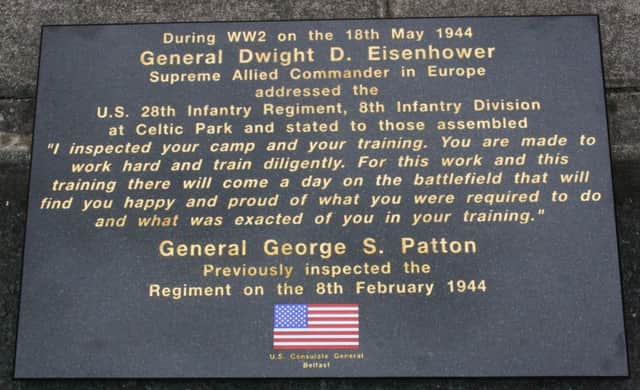Colours captured in stone... where thousands marched off into history


The RSPB’s guide to British birds describes the beautiful, incredibly coloured Kingfisher as “a small, unmistakable, bright-blue and orange bird” that flies rapidly “over slow-moving or still water.”
Brought up in green, undulating countryside around Enniskillen where rolling green drumlins were lapped by Lough Erne’s countless rivers and lakes, Roamer’s childhood was spent roaming a magical county that was very adequately plumbed with “slow-moving and still water”!
Advertisement
Hide AdAdvertisement
Hide AdOne of my long-abiding memories is my father’s captivating description of his favourite bird - the Kingfisher.
He told me that I’d be very privileged to observe one, with its pointed beak and magical colouring.
“They’re extremely hard to see because they fly so fast,” he explained “but if there’s a sudden flash of blue in the air, that’ll be a Kingfisher!”
The first time I saw dad’s “flash of blue” I understood what he meant.
Advertisement
Hide AdAdvertisement
Hide AdI didn’t see the Kingfisher, but the fleeting burst of colour was so distinctive that I was absolutely assured of its presence.
Many bright gems in our heritage - whether local history, countryside or culture - are equally difficult to spot.
Particularly if there’s no one like my father to point out the clues!
Co-incidentally, it was a “flash of blue” the other day that beckoned me to one of Carrickfergus’s oft-forgotten gems.
Advertisement
Hide AdAdvertisement
Hide AdWhilst driving into the beautiful and historic ship-building town that once eclipsed Belfast’s comparatively tiny out-put of ships, I glimpsed a blue sign on the wall of a house.
It was the Ulster History Circle’s plaque on Marine Cottage, Belfast Road, former home of local shipbuilder Paul Rodgers.
The steel schooner Result, currently in the Ulster Folk and Transport museum, was the last sailing ship to be built at the Carrickfergus shipyard in 1893 and was the final development of a significant series of schooners designed by Rodgers.
The fleeting “flash of blue” as I drove past his house reminded me of his truly great maritime legacy, even though Rodgers and his historic ships are no longer part of the local landscape.
Advertisement
Hide AdAdvertisement
Hide AdToday, back in Co Fermanagh, the U.S. Consul General Daniel Lawton’s will pay his first official to Enniskillen to mark the county’s vital role in WWII.
Mr Lawton will make several poignant pilgrimages during the morning, one of them close to the lake where I glimpsed my first flash of a Kingfisher.
Just like it, and Paul Rodgers’ ships, there’s little or nothing to be seen on Enniskillen’s grassy Celtic Park that reveals a hugely significant presence from its past.
But today, the anniversary of an historic event that took place there 72 years ago, a handsome granite plinth will be much more than a clue to a momentous occasion.
Advertisement
Hide AdAdvertisement
Hide AdGeneral Eisenhower, the Supreme Commander of Allied Forces, later to become the 34th President of the United States, inspected and addressed American troops at Celtic Park on May 18 in 1944 before travelling to Portora Playing Fields for a Regimental Review.
Mr Lawton will unveil the commemorative plinth at the Model School, adjacent to Celtic Park.
Funded by Belfast’s U.S. Consulate General in Belfast and Enniskillen’s Headhunters Railway Museum, the plinth will shortly be positioned in the stone wall at the Dublin Road entrance to the new school, where Eisenhower was welcomed when he arrived at the U.S. Camp.
Celtic Park was one of over 20 important American military and sea-plane bases dotted across Fermanagh.
Advertisement
Hide AdAdvertisement
Hide AdDuring the build-up to D-Day on June 6, 1944, a quarter of the county’s population consisted of American military personnel and Celtic Park was the Regimental Headquarters.
The U.S. Army’s iconic General George Smith Patton reviewed troops there on February 8, several months before General Eisenhower arrived and inspected 2,000 GIs at Portora.
Just four days before Ike’s visit, a grotto was consecrated at a tragic crash site in the nearby Graan monastery where seven American airmen died when their plane crash-landed the previous year.
Amidst the sadness, Ike’s historic review confirmed his Fermanagh-based troops’ readiness for D-Day.
Advertisement
Hide AdAdvertisement
Hide AdHe reported that they showed “exactly the same signs of fitness and training” as the 3rd Infantry Division had displayed on the Mediterranean front.
The invasion of Europe was ‘the beginning of the end of the war’ which for many young Americans began in Fermanagh.
The U.S. Consul General’s visit today will begin at the Graan where he’ll be welcomed by Father Brian D’Arcy.
They’ll reflect on the tragedy of the seven U.S. aircrew who died when their Flying Fortress aircraft, The Galley Uncle, crashed on December 9, 1943.
Advertisement
Hide AdAdvertisement
Hide AdPriests heroically rescued five survivors from the burning wreckage and grateful U.S. soldiers contributed £250 for the erection of a white marble statue in Our Lady’s Bower at the Graan.
Mr Lawton will lay flowers at the memorial, which now bears the names of all the crew members of The Galley Uncle.
Later this morning he’ll visit Enniskillen Model School to present the commemorative plinth to its pupils, engraved with an outline of General Eisenhower’s historic visit -
“I inspected your camp and your training. You are made to work hard and train diligently.
Advertisement
Hide AdAdvertisement
Hide Ad“For this work and this training there will come a day on the battlefield that will find you happy and proud of what you were required to do and what was exacted of you in your training.”
The Kingfisher has departed but its colours are captured in stone.